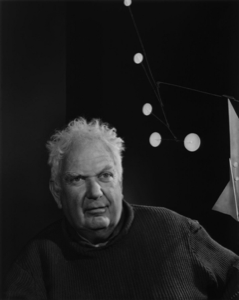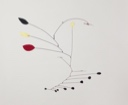Alexander Calder
American, (1898–1976)
Born in Lawnton, Pennsylvania, to artist parents, Calder studied painting at the Art Students League in New York before moving to Paris in 1926. There, he gained renown for his Cirque Calder, a multipart artwork comprising dozens of miniature handmade objects, which he performed for audiences of artist colleagues and friends. With a series of human likenesses made from wire bent into formation, Calder used line to float shape, levitate it, and remove sculpture from the pedestal, evoking volume without the accompanying mass.
A 1930 visit to the Dutch painter Piet Mondrian’s Paris studio—a workspace arranged like an abstract environment—prompted a radical shift in Calder’s art, from an art of observing things in the world toward an art that opens up a world unto itself. He began to develop the kind of work for which he would become best known: the mobile—an abstract sculpture that moves—so named by Calder’s friend Marcel Duchamp. With this new art form came a new set of possibilities for what a sculpture might be. Rejecting the traditional understanding of sculpture as grounded, static, and dense, Calder made way for a consideration of volume, motion, and space.
Some of his earliest mobiles were motor-activated and displayed on pedestals or hung from walls. Others moved freely in response to air currents or viewer intervention, and were suspended from the ceiling or placed directly on the floor. He would continue to explore the possibilities of this abstract visual language for the rest of his career, working primarily between studios in Roxbury, Connecticut, and Saché, France, eventually shifting focus to monumental constructions and public works.
Source: MOMA.org
American, (1898–1976)
Born in Lawnton, Pennsylvania, to artist parents, Calder studied painting at the Art Students League in New York before moving to Paris in 1926. There, he gained renown for his Cirque Calder, a multipart artwork comprising dozens of miniature handmade objects, which he performed for audiences of artist colleagues and friends. With a series of human likenesses made from wire bent into formation, Calder used line to float shape, levitate it, and remove sculpture from the pedestal, evoking volume without the accompanying mass.
A 1930 visit to the Dutch painter Piet Mondrian’s Paris studio—a workspace arranged like an abstract environment—prompted a radical shift in Calder’s art, from an art of observing things in the world toward an art that opens up a world unto itself. He began to develop the kind of work for which he would become best known: the mobile—an abstract sculpture that moves—so named by Calder’s friend Marcel Duchamp. With this new art form came a new set of possibilities for what a sculpture might be. Rejecting the traditional understanding of sculpture as grounded, static, and dense, Calder made way for a consideration of volume, motion, and space.
Some of his earliest mobiles were motor-activated and displayed on pedestals or hung from walls. Others moved freely in response to air currents or viewer intervention, and were suspended from the ceiling or placed directly on the floor. He would continue to explore the possibilities of this abstract visual language for the rest of his career, working primarily between studios in Roxbury, Connecticut, and Saché, France, eventually shifting focus to monumental constructions and public works.
Source: MOMA.org
Artist Objects
Mobile, 15 Leaf 1992.037


